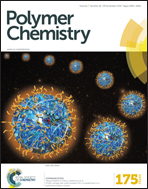Supramolecular engineering polyesters: endgroup functionalization of glycol modified PET with ureidopyrimidinone†
Abstract
The benefits of supramolecular polymers include recyclability, self-healing, and processability. While the effect of the supramolecular ureidopyrimidinone (UPy) endgroup has been investigated on many low-performing, aliphatic polymers, the effect of the UPy group has not been broadly investigated with higher performance materials. High molecular weight engineering plastics have excellent mechanical properties, but they can be difficult to process. By end-functionalizing low molecular weight engineering polymers with a supramolecular moiety, issues involving processability could be overcome while maintaining robust mechanical properties. Herein, the structure–property relationships of end-functionalized glycol-modified poly(ethylene terephthalate) (PETG) of various molecular weights were investigated using the quadruple hydrogen bonding UPy group and various linkers. By taking advantage of the unique thermal properties of PETG, this system serves as the first example of a supramolecular engineering polymer with enhanced thermal and mechanical properties that also shows improved melt viscosity at temperatures suitable for safe, non-degradative processing.


 Please wait while we load your content...
Please wait while we load your content...